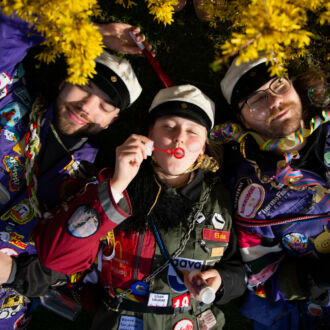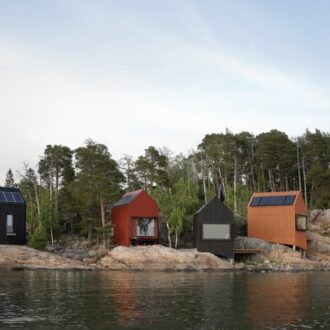The open sea lies before you, the spring warmth and a light wind have split the sea ice into floes that rock lazily on small waves. Beyond the horizon, on the other side of this body of water, lies Sweden. In between, there is only water — or there ought to be only water.
There are pale columns ‘dancing’ on the horizon! Looking along the shore, you see distant islands, whose low, thin silhouettes grow into steep rock faces. The entire shoreline takes on the shape of a rock wall where the familiar outlines are impossible to find; a mirage distorts the shores of Finland!
Most people’s impression of mirages comes from comic books, for instance the elusive and distant mirage of an oasis which tends to appear to Donald Duck during adventures in the desert. People consequently tend to conclude that the mirage is a phenomenon produced by the delusions of a person who is exhausted by heat and thirst, a hallucination which exists only in the imagination of that person, rather than something which can be documented in, for instance, photographs. On the other hand, most people are familiar with the shimmering pools of water that can often been seen on hot pavements on summer days. These apparent pools are not given any mystical connotations, however, even if they are in fact the same phenomenon as the mirage of an oasis in the desert: the sky and its blue colour appear to be reflected above a hot surface, producing an illusion of water, which constantly recedes out of reach before the approaching traveller.
There are a number of possible explanations for the mystique of mirages. The cold northern sea off the coast of Finland is an exotic experience in itself and has proved a fertile source for traveller’s tales but it is also an exceptionally good place for seeing incredible mirages. In the past, seafarers who had visited all kinds of faraway places and seen all kinds of marvels usually developed something of a reputation as storytellers. Their stories were often extraordinary, but talk of ships sailing upside down and the sight of palaces and vast meadows out in the middle of the ocean must have sounded particularly strange. Since telescopes and binoculars had not been invented yet, people’s imagination added the detail and colour to the stories of the things they had seen. Mirages appeared seemingly at random, they might be visible only for a brief moment, they changed shape and disappeared as you approached them, observers at different heights saw different types of mirages, and so on. The only explanation seemed to be some unknown force under the trackless waves, which had the power to shift all manner of marvels between the underwater world and the world above the surface!
Shifting horizons and eerie ships
The word mirage can be more accurately defined by explaining that atmospheric conditions can cause deviation of the normally straight movement of light rays, creating a situation where an object is perceived as displaced or distorted. Mirages are usually seen at the horizon and with a very small angular diameter, yet they may take a number of shapes. The shrubs and rocks on a small island may tower into the sky; low, sloping shores may be vertically stretched so they look like precipices; a ship and its deck superstructures may distort into unidentifiable boxy shapes; entire islands seem to float in the air with inverted mirages below them; a number of mirages of the same island appear, now right way up, now upside down, above the island; a ship is seen to travel along the distant horizon upside down; the setting sun looks square, splits up into slices and gives off a final, bright green flash before going down. Sailors who spend more time in Finnish waters inevitably come up against mirages; seasoned navigators and sailors who know their channels are well aware that there are conditions in which it is extremely difficult to find a familiar route among the confusing mirages obscuring a rocky shoreline; people who use radar may remember occasions on which the radar range seemed strangely limited or other occasions when the radar range seemed to extend past the normal horizon. Sometimes, there is a mention on the news for TV viewers and mobile phone users that meteorological conditions are causing transmission disturbances. Mirages caused by atmospheric conditions are everywhere; usually only as a marginal phenomenon for those who look for it, but sometimes to the extent where it interferes with our everyday lives.
A ship of many shapes
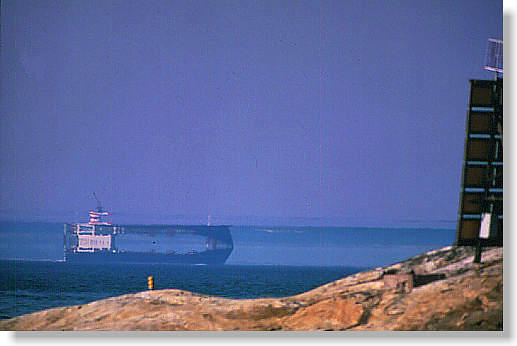
On April 20, 1999 an ordinary freighter was plying the waters of Finland’s south-western archipelago. But what Pekka Parviainen saw on that day was anything but ordinary. The ship turned up in a number of different shapes; sometimes there seemed to be two ships, one of the pair upside down. Luckily Pekka had brought his video camera with him. Here is part of his footage for you to enjoy. On a day like this Finland is full of mirages!
The refraction of light
Air gets thinner the higher you are from the surface of the earth or the sea. In normal conditions, the density of air decreases with increasing altitude. When light rays travel along the surface of the earth, the air below the light ray is therefore denser than the air above it. One of the typical properties of light is that it refracts towards the denser medium, and thus a ray moving along the surface of the earth is in fact constantly refracted slightly downward, following the earth’s curve instead of escaping straight into space. Imagine if you will that the denser air exerts a kind of friction on the ray of light, drawing it towards itself. When we see something, we imagine that the object we are seeing is in the direction from which its light reaches our eyes. But when we look at the distant horizon, we see objects which are in fact partly below the horizon. The light from these objects is refracted in a low curve along the curved surface of land or sea, and reaches the observer’s eye from what only appears to be the direction of the horizon. Many people must be familiar with the often repeated fact that when we are looking at the setting sun, it is in fact already below the horizon. In astronomy, this phenomenon is known as refraction: the refraction of light in the atmosphere raises objects in the sky at the horizon by about half an (angular) degree.
This is all very well, but Nature has a way of surprising us: very often, the density of air does not change consistently with the altitude, and instead, colder, denser air and warmer air form layers of different temperatures at different altitudes. The movement of light in this kind of stratified ocean of air can be quite erratic, thus creating a strongly distorted image of the landscape — mirages, in other words. The stratification of the air, furthermore, is not necessarily clearly defined or stable, yet it may at times be strong enough to create at least a moment’s amazing mirages. In Finland, the conditions for mirages are particularly favourable in spring, when the sea ice thaws. Sea water of 0° C combined with a spring ‘heat wave’ of 15° C in the air can create miraculous images.
The two paths of light
Keeping in mind that light is refracted towards colder air, let us consider some of the peculiar things you might see out at sea, for instance. In late summer and early autumn in Finland, the nights quickly get colder and air temperatures drop rapidly above the heat-retaining sea water. The sea warms a layer of air a few centimetres above the water, however, creating a thin layer of warm, thus less dense, air just above the water surface. When the light is reflected off a distant island towards the observer, it might consequently find two different paths: one ‘normal’ path travelling clearly above the surface of the water almost straight to the eye of the observer, the other moving at a low angle toward the water surface, where it is refracted at a height of a few centimetres up toward the colder air, reaching the observer’s eye from an angle below the line of sight. This means that the observer sees two images of the island, one normal and the other an inverted mirage hanging below the island. This is called an inferior mirage.
The inferior mirage
Inferior mirages are quite common. For instance, the water seen on desert sand or on hot pavement is a mirage of sky above the hot sand or asphalt. Landing aircraft in films or car races on television are often filmed from a point quite close to the surface of the hot tarmac of the runway or race track. This means that below the car or plane, you can see a mirage of the sky, but also an inverted image of the actual car or plane — its inferior mirage. In this same way, if you look at an object along, for instance, the wall of a house which is warmed by the sun, you can almost always see a mirage of the object very close to the surface of the wall. Inferior mirages by the sea in autumn are worth investigating by trying out different observation heights: the higher you are as you watch the phenomenon, the less visible it becomes. Meanwhile, the lower you go to watch the phenomenon, the thicker the slice that the mirage ‘cuts’ off the horizon to project the inferior mirage on. Sailors know this phenomenon well: islands look suspended in mid-air. The impression occurs when you watch the seascape from a boat and your eye level is between two and three metres above the water surface. A thin slice of sky above the horizon and the inferior mirage below it become ‘welded together’. The mirage of the island is seen at this height as a strongly flattened slightly rounded ‘bottom half’ of the island, outlined as a dark shape with the island itself “in mid-air along the welding seam”.
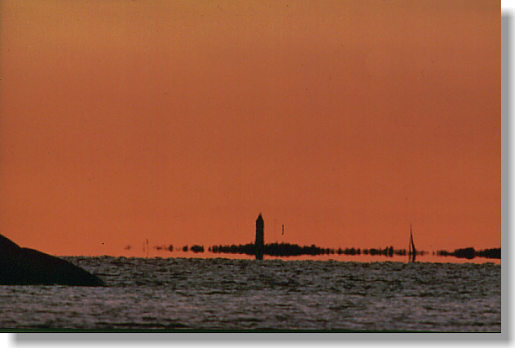
In this picture the sailing boat has almost disappeared into the inferior mirage. Only the sail is visible.

The lighthouse of Isokari, near Kustavi, in the south-western archipelago.
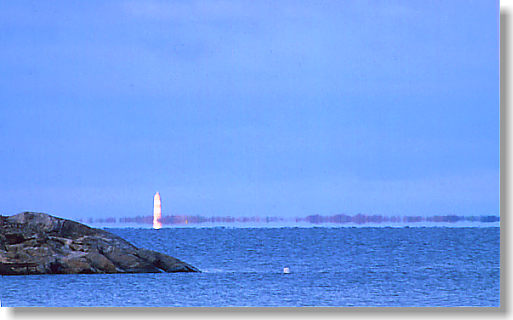
Another view of the Isokari lighthouse.
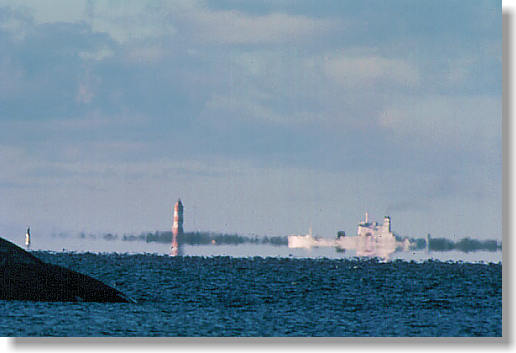
An inferior mirage and the mirage of a ship.
The inferior mirage as a phenomenon is rather monotonous: there is always only one inverted mirage below the object and the mirage is always more or less flattened. If the actual landscape itself is beautiful, then so is the mirage, and they may spread together across the horizon as a string of buildings and treetops. As a phenomenon the inferior mirage is, however, always identical in structure and easy enough to understand. As a phenomenon of physics, it is devoid of interest.
The two paths of light in a thermal inversion
In spring the reverse of the stratified temperatures described above may occur over the sea or a big lake: the cold water, recently freed from winter ice, is covered by a warm layer of air from above the land. Favourable conditions for this occur when the wind blows seaward off the land. In such situations in Finland, there is often a dry, warm wind from deep within the Russian steppes, driving the first spring warmth out over the open sea. Again, the light reflected off a distant island finds two paths to the observer’s eye; again, one of these paths is almost straight from the island to the observer, but this time the other leaves the island at a slight upward angle towards the warmer air, being refracted at the boundary between the air layers down toward colder air and reaching the observer’s eye from an angle above the line of sight. This, again, creates two images of the island, one ‘normal’, but this time the other image is an inverted mirage above the island. This is called a superior mirage. The particular type of atmospheric condition which creates superior mirages is called thermal inversion, i.e. a clearly defined, lighter and less dense layer of warm air rests on top of a cold air mass. Powerful thermal inversion is also the cause of the occasional disturbances of radio and television reception and mobile phone transmissions.
The superior mirage
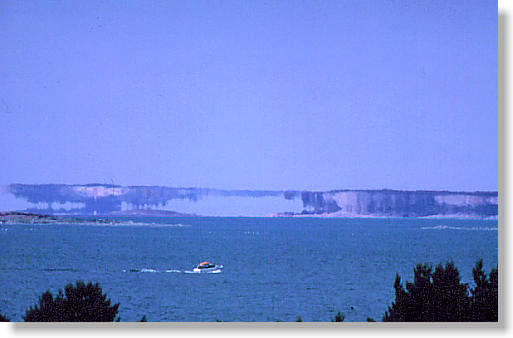
A sailing boat with a typical superior mirage in the background.
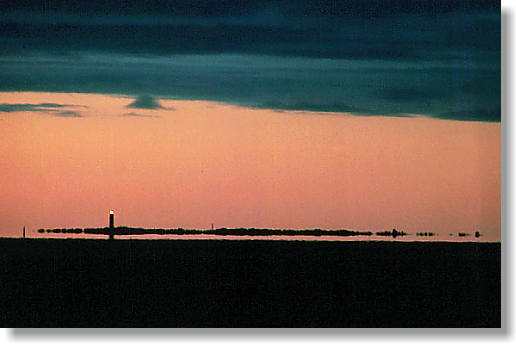
A small boat with a superior mirage of islands.

A superior mirage with a sailing boat.
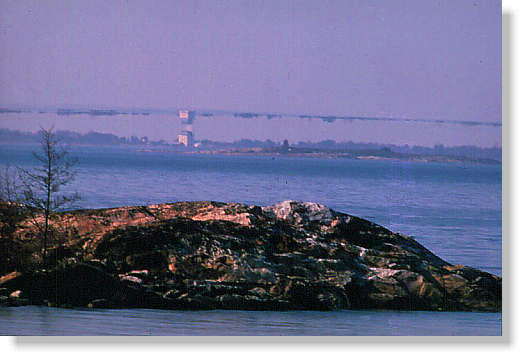
A house in the archipelago with a superior mirage.
The type of air layers in a thermal inversion can vary a great deal: sometimes the warm air mass is thick, sometimes it is thin and hot, sometimes there are several warm layers, and the temperature profile of the air layer near the earth and the vertical temperature gradient may fluctuate wildly. As a consequence, the superior mirages caused by this can be extremely strange. At sea, there may not be a single ‘normal’ image of an island, and instead the parts of the island at different elevations are flattened or elongated in several different ways; there may be up to four mirages above the distorted island, visible now right side up, now upside down, and flatter the higher up they are. Islands at different distances also produce different mirages. In this kind of situation, if you can look towards land from your position out at sea, the shoreline will be visible as a wall of roughly even height, where elongated mirages of lighter rocks and darker trees make speckles on the wall. On the open sea, low waves may reach into the mirage-producing air layer, where they become vertically stretched into high columns: this produces a vision of dancing columns far out to sea. If the height of the thermal inversion layer is variable, the mirage may raise parts of the sea surface up into the air, causing the appearance of ‘castles in the air’ which rise and then crumble into the waves in an instant. These exceptionally impressive mirages are also called Fata Morgana. (The phenomenon was named after King Arthur’s wicked stepsister, the sorceress Morgan le Fay, who, according to some legends, lived in a crystal palace under the waves and manifested her magical powers by creating mirages.)
Hunt for mirages with your binoculars
In order to see mirages, you need a wide and fairly even horizontal surface that the air can form layers above. The alternation of air temperatures in the different layers at different altitudes causes vertical distortion of objects. In contrast, the formation of vertical layers of air with subsequent clear and stable horizontal mirages is not possible. The only exception is the situation mentioned before, where a wall is heated by the sun and an inferior mirage is created between an object and the wall. A mirage always has a small angular height, and therefore it is much easier to discover the phenomenon and observe it in more detail with the help of binoculars than with the naked eye.
Mirages require searching and waiting
Inferior mirages are clearly visible near a warm sea surface, but an elevation of as little as a couple of metres may cause the phenomenon to go unnoticed unless you are already familiar with it. On the other hand, as the phenomenon occurs very frequently in late summer and early autumn, it is easy to see if you make a slight effort. Superior mirages, meanwhile, are much more rare than inferior ones and also very sensitive to just the right viewing height. A deviation of as little as one or two metres up or down may prevent you from seeing the mirage at all. Therefore, when conditions seem favourable — for instance the first warm spring day by a cold sea — it is a good idea to scan the horizon from positions at different heights. Here, one clue to the possible presence of mirages can be a dark stripe along the horizon, looking like a thin layer of pollution fog. If you see this, it is well worth experimenting with different viewing heights to look for good mirages; it may even be worth waiting around for them. The wind should be blowing at a few m/s from the warm land mass; should the wind be too strong, even 6-8 m/s, it tends to mix up the air layers. It is nevertheless also true that on the coast of the Gulf of Finland, a long-term current of warm air across the sea from Estonia may be just right for creating conditions which are conducive to mirages. Your chances of seeing superior mirages may, however, be further complicated by poor visibility; these mirages are usually visible out at sea affecting islands at a distance of about 15-30 kilometres, and at that distance, even a slight haze is enough to cloud the contrast and spoil the visibility of the mirage. Fortunately, warm spring air currents are often dry in Finland and thus offer good opportunities for looking for mirages. After all the trouble, it is usually well worth the effort when you actually see a mirage, which at best can distort the landscape in the most incredible way. If and when you come across this natural phenomenon, be grateful for the opportunity and make the most of the atmospheric optics!
The green flash
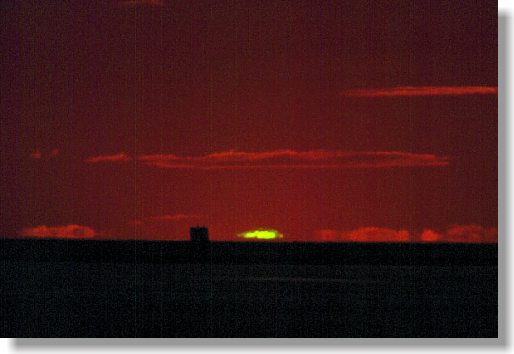
In the context of mirages, we should not forget sunsets, because so many people watch them and therefore often witness the surprising tricks of the atmosphere — possibly even without ever realizing it. Even the setting sun is usually too bright to watch with the naked eye, so a piece of exposed film or the grey filter from a camera is useful. (At sunset, the film you use can even be a piece of exposed colour film, unlike when the sun is high in the sky, when only exposed black and white film is safe.) Unlike the conditions in daytime landscapes, the sunset is never spoilt by a slight haze. Furthermore, the sunlight passes twice through the entire atmosphere, so clear distortions are much more common than good superior mirages. The sun can be distorted in the most amazing ways: it splits up into slices; it looks almost square when it sets; the disc of the sun takes on the shape of a Chinese lantern; after it has actually set, the sun may sometimes float above the horizon as a needle-thin strip for 10-15 minutes before finally disappearing; the sun may have the shape of a pot, a peaked cap, a vase, a cauldron, an atom bomb… On the surface of the sun, dark sunspots may be vertically elongated into dark columns or double like ordinary mirages. At sunset it is possible to see anything! Some people may be familiar with one of Nature’s most exciting surprises: sometimes the very last ray of the setting sun is bright green, a pure, metallic shade of green which would be considered utterly mendacious if a painter dared to include it in his painting. Jules Verne has written an entire novel on the theme of this green flash (Le Rayon vert). It is said that whosoever sees it shall never be short of luck in love! Surely that alone is a good enough reason to go looking for mirages on the horizon?
Pekka Parviainen’s pictures of the sun in different shapes
Text and photos by Pekka Parviainen, mathematics lecturer, University of Turku, December 2001
















